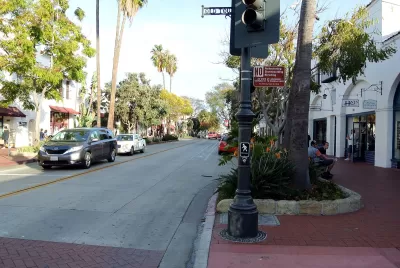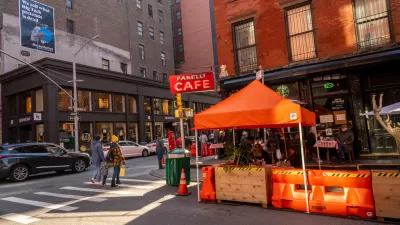The city will consider adjustments to its outdoor dining policy after the fire department expressed concerns about access for emergency vehicles.

Social distancing restrictions imposed during the pandemic forced cities to rapidly implement outdoor dining programs, and Santa Barbara, with its bustling downtown restaurant scene, was no exception. Now, at the Fire Department's request, the city may remove or alter around 25 outdoor seating areas approved under the COVID-19 program. As John Palminteri reports, "The Santa Barbara City Fire Department says it needs 20-feet down the middle of the street in the area where they only have a space of 14 and a half feet," a number that the fire department previously agreed to.
The city is now evaluating the regulations for its outdoor dining program and plans to amend the rules to address concerns from first responders, business owners, and local residents, as well as other design changes for the city's downtown.
Although the concept of parklets—public or private seating or dining areas created from curbside or surface parking—has been around for years, COVID-19 led to an explosion of "pandemic dining" projects, with cities scrambling to create regulations and balance the need for more outdoor dining and seating with traditional street uses and user safety concerns. Cities around the country embraced "al fresco dining" and "open streets," inadvertently creating models for what could be permanent fixtures of future cities, where street space is reimagined to serve a broader segment of users and purposes.
FULL STORY: Many parklets and patios could be cut back in the Santa Barbara promenade by early March

Planetizen Federal Action Tracker
A weekly monitor of how Trump’s orders and actions are impacting planners and planning in America.

Chicago’s Ghost Rails
Just beneath the surface of the modern city lie the remnants of its expansive early 20th-century streetcar system.

San Antonio and Austin are Fusing Into one Massive Megaregion
The region spanning the two central Texas cities is growing fast, posing challenges for local infrastructure and water supplies.

Since Zion's Shuttles Went Electric “The Smog is Gone”
Visitors to Zion National Park can enjoy the canyon via the nation’s first fully electric park shuttle system.

Trump Distributing DOT Safety Funds at 1/10 Rate of Biden
Funds for Safe Streets and other transportation safety and equity programs are being held up by administrative reviews and conflicts with the Trump administration’s priorities.

German Cities Subsidize Taxis for Women Amid Wave of Violence
Free or low-cost taxi rides can help women navigate cities more safely, but critics say the programs don't address the root causes of violence against women.
Urban Design for Planners 1: Software Tools
This six-course series explores essential urban design concepts using open source software and equips planners with the tools they need to participate fully in the urban design process.
Planning for Universal Design
Learn the tools for implementing Universal Design in planning regulations.
planning NEXT
Appalachian Highlands Housing Partners
Mpact (founded as Rail~Volution)
City of Camden Redevelopment Agency
City of Astoria
City of Portland
City of Laramie





























